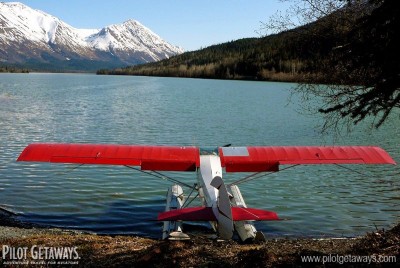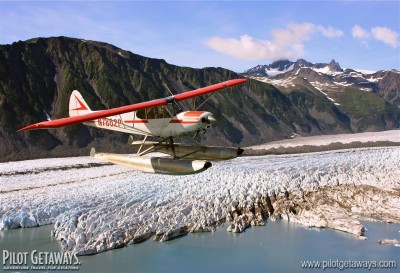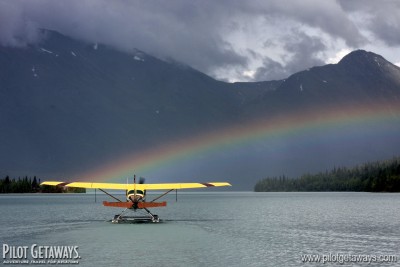You are hereBlogs / Crista Worthy's blog / Seaplane Rating with Alaska Float Ratings
Seaplane Rating with Alaska Float Ratings
I found the end of my rainbow in Moose Pass, Alaska, a couple of weeks ago.
After writing about Alaska Float Ratings (pglinks.net/mj13), I decided to take my own advice and go get a seaplane rating. Evan, one of Alaska Float Ratings' great CFIs, picked me up in Anchorage in a Cessna 172 on floats. A short 30-min flight through the green-carpeted, glacier-carved Chugach Mountains brought us to Upper Trail Lake, home of Alaska Float Ratings and Scenic Mountain Air. Vern Kingsford has been a CFI for 49 years and has developed an exceptional program!
www.alaskafloatratings.com
Upon arriving at Upper Trail Lake, Moose Pass, where Alaska Float Ratings is based, I greeted the staff and was escorted to my private and very comfortable cabin (with shower, heat, fridge, and sink), just a few steps away from the docks. Even though it was very light out, it was 10:30 at night and time to get some rest before our training began the next morning.

I had spent substantial time at home getting ready for the seaplane course, which turned out to be a very good idea. All students should come prepared because there isn’t a minute of your precious time wasted here. It’s all Class G so you taxi out and get going right away, with about a dozen lakes within a few minutes’ flight, each a different milky turquoise color, size, and shape. One day we landed on a tiny remote lake chock full of Arctic Grayling. The lakes are at 500 MSL but the mountains rise to about 6,000 MSL with narrow canyons everywhere, so it’s real Alaska mountain flying.
The transition from the Cessna I'm used to, to a Super Cub, was easy; it’s such a fun and intuitive airplane to fly. I flew two different Super Cubs with different floats and instrument arrangements and with three different CFIs. I found alternating instructors to be a huge advantage, as you get different perspectives. With floats, nothing is laid out for you—you have to watch everything and decide how to proceed, read the wind patterns on the lakes, which change often, look for debris, and choose touchdown and abort points, etc.
One of their many superb training exercises is called the Roller Coaster. Take off and then pull the power to idle at 100 feet to simulate an engine failure at that worst time. You learn just how quickly you have to push the stick forward to maintain glide speed. Next thing you know, you are pointed right down at the water. The anticipation of impact makes you want to pull back and flare but if you do, you’ll drop the airplane, so they teach you how to wait and pitch up at just the right time to set it down nice and smooth on the water… then full power again, take off, 100 feet, pull the power, and back down you go, over and over. This burns the actions needed for an engine failure after takeoff into your muscles and brain, and burns that sight image in, of coming down and not pulling back too soon. What a great lesson for this type of emergency, one that applies to both land and seaplanes! I could never get this sight picture and practice at altitude, and I never had a CFI do this on land either.
 It has always been my ultimate flying dream: to fly in Alaska. The Kenai Peninsula has it all: gorgeous blue lakes, giant glaciers, big bears, moose, eagles, salmon, and wonderful fishing. When you're up in a float plane with so many gorgeous lakes to choose from below, the world becomes your oyster. And flying a Super Cub on floats in this challenging environment not only improved my stick and rudder skills, it got my eyes out of the cockpit looking for clues everywhere: ripples on the water, leaves blowing in the wind, crosswind gusts--you could actually see them coming. One day I watched a bald eagle circle below me, riding a thermal and looking for a meal below. Alaska is a national treasure.
It has always been my ultimate flying dream: to fly in Alaska. The Kenai Peninsula has it all: gorgeous blue lakes, giant glaciers, big bears, moose, eagles, salmon, and wonderful fishing. When you're up in a float plane with so many gorgeous lakes to choose from below, the world becomes your oyster. And flying a Super Cub on floats in this challenging environment not only improved my stick and rudder skills, it got my eyes out of the cockpit looking for clues everywhere: ripples on the water, leaves blowing in the wind, crosswind gusts--you could actually see them coming. One day I watched a bald eagle circle below me, riding a thermal and looking for a meal below. Alaska is a national treasure.
Summer's not over—I'm hankering to go back for more!






Christa—
Glad to see that you, too, have found how much fun flying floats can be on the Kenai peninsula.
I had to smile at your e-missive on finding a compatible flight instructor. Your recollection of crosswind landing training early on reminded me of my days as a post-solo student so many years ago. Flying a 65 hp Aeronca 7AC with heel brakes, and deciding my landings were getting a bit ungainly, I set up a review session with my instructor. He quickly allowed as how my problem was actually trying to land the plane, when what I should be doing was trying to find the sweet spot and hold it off inches above the pavement. What he had me practice was flying the full length of the runway at about 6 inches off the ground, learning the forward and peripheral vision sight cues that ingrained what a float, balloon, or sinker looked and felt like. It worked wonders. In fact, flying with Vern in one of his Super Cubs a few years back he tasked me with the same concept down the length of one of the many lakes up there. One pass down the lake and he'd seen enough to know that I didn't need to demonstrate a sense of where the surface was. On to other lessons.
I seem to have lost your e-dress, so I hope this gets to you, and finds you well and happy.
Cheers, Tom Close
In response to Christy Worthy's article on the "Staggerwing" Beech, brought back delightful memories. In the 50's I worked for an FBO that was contracted by a company to rebuild a Staggerwing for corporate use. We did a complete overhaul including replacing many of the little plywood gussets and Irish linen. I remember my fingers getting sore from tying all the rib-stitching involved by plunging that needle about every 3/4 inch down through the plywood on the wings and the linen and tying off. After finishing the job, the company Private pilot that owned the beauty confessed to me he was afraid of it, and would I fly it with him. Would I ever? I said OK, as long as I sat on the left with the control wheel on my side. The flight was all I knew it had to be, and more. At redline, the skin was smooth as glass. He said, "do you think we could loop it?" Well I'm sure. At the top of the loop I saw we we were not going to get quite over before it stalled. Which it did. We snapped upright and continued on into land. Parking at the hangar and getting out we noticed all the red stain from 87 octane on the wings. My boss said, "well we know who gets to sand and paint." Years later, Olive Ann Beech presented me with an autographed book about the old Staggerwing. Those were the days.